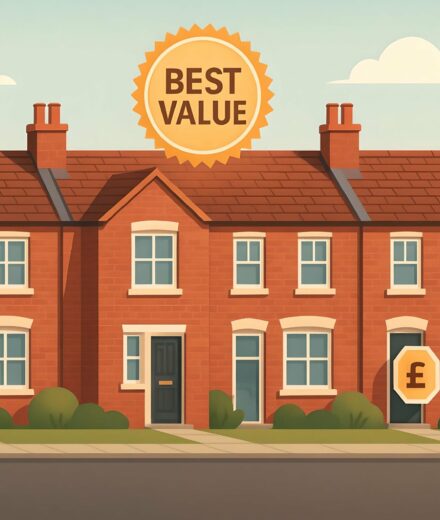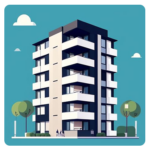

House Prices > Preston
| Year | Average Price | Transactions |
|---|---|---|
| 2025 (proj.) | £231,700 | 5,688 |
| 2024 | £225,400 | 4,043 |
| 2023 | £230,800 | 5,391 |
| 2022 | £224,400 | 6,722 |
| 2021 | £220,700 | 7,150 |
| 2020 | £208,200 | 5,230 |
| 2019 | £196,200 | 5,526 |
| 2018 | £191,600 | 5,752 |
Preston’s property market has shown steady, unmistakable progression since 2018. Prices are climbing faster than a cat up a lamppost on Fishergate. We’re not just talking about modest bumps – the average home price has managed to rise each year, apart from a tiny pause in 2024, before surging again in the 2025 projections.
Buyers eyeing Preston shouldn’t expect bargains simply because transaction volumes have cooled. Instead, think of today’s market as selective, rather than sluggish. Supply remains tight, particularly in family-friendly hotspots and leafy suburbs. If you’re a seller, there’s still strong appetite for well-presented, well-placed homes.
The takeaway is simple. Preston property prices are doggedly upward, transaction activity is zigzagging, and those thinking about their next move should keep a close eye. If you’re looking to buy, the time to act decisively is now.
Thinking about buying in Preston? You might want to scroll through the live houses for sale in Preston.

Avg. Property Price: £391,100
Avg. Size of Property
1,549 sq/ft
Avg. Cost Per Sq/ft
£261 sq/ft
Total transactions
2,214 (since 2021)

Avg. Property Price: £215,700
Avg. Size of Property
1,003 sq/ft
Avg. Cost Per Sq/ft
£221 sq/ft
Total transactions
1,305 (since 2021)

Avg. Property Price: £124,100
Avg. Size of Property
849 sq/ft
Avg. Cost Per Sq/ft
£150 sq/ft
Total transactions
2,256 (since 2021)

Avg. Property Price: £115,500
Avg. Size of Property
672 sq/ft
Avg. Cost Per Sq/ft
£176 sq/ft
Total transactions
138 (since 2021)
Preston’s property market reveals a fascinating mix when you dig into pricing across different property types. There’s a clear hierarchy when it comes to both space and prestige, with detached homes standing tall as the crown jewels of the city’s property scene. Yet, the story doesn’t end there. Each property type offers its own unique flavour and appeal, reflecting Preston’s vibrant neighbourhoods and diverse residents.
Detached homes in Preston truly dominate on price and space. These spacious retreats command a premium, and with an average footprint that’d have most buyers stretching their arms in delight, you get a strong sense of exclusivity. These homes are the showstoppers, often nestled in leafy lanes or tucked away on sought-after streets. Even so, the higher cost per sq/ft suggests that for many Preston buyers, privacy and that all-important garden are absolutely worth every penny.
Yet, if you follow the steady beat of the property market, it’s terraced and semi-detached homes that keep things moving at a brisk pace – moving quicker than a Saturday crowd heading into the Indoor Market. Semi-detached homes strike a gentle balance between generous space and relative affordability, often becoming the first serious upgrade for young families or professionals seeking more room. The cost-per-square-foot sits neatly in the middle, meaning families get a little extra elbow room without breaking the bank.
Terraced homes, meanwhile, continue to punch above their weight in Preston. They often have character, clever layouts and are scattered in well-established neighbourhoods. It’s no coincidence they’re among the most frequently transacted homes. Their price point keeps the doors open for buyers looking for city life on a sensible budget.
Flats sit at the entry point of Preston’s market, making them a popular option for first-timers, students, or anyone prioritising location over size. Smaller in scale and cosier, but with the lowest cost per sq/ft, these properties keep the city’s ladder accessible and offer relatively good value in more urban settings.
When you look at the Preston market as a whole, the price gradient across property types paints a clear picture of the city’s values: space, independence, and location all command a different kind of premium. Yet with choices available at every rung, buyers from all walks of life continue to find their place in Preston’s ever-shifting mosaic.
For buyers and sellers alike, appreciating the different price bands and typical transaction volumes across property types is crucial. If you’re thinking of selling and want to know how your property stacks up, see our detailed guide on how to value your home in Preston.
| District | Avg Price (£) | Transactions |
|---|---|---|
| PR1 | £153,800 | 7,791 |
| PR2 | £185,600 | 9,347 |
| PR3 | £275,500 | 7,260 |
| PR4 | £255,400 | 10,468 |
| PR5 | £187,400 | 5,253 |
Preston’s property scene is full of contrasts, with house prices and sales volumes twisting and turning as you head from one postcode district to another. At one end, you find vibrant city-centre streets and new developments; at another, leafy village lanes set a more tranquil pace. Yet the data uncovers just how much postcode influences both price and popularity.
Looking at the lower end, certain central Preston districts are noticeably more accessible for first-time buyers or those hunting for a place that’s both energetic and affordable. These areas often attract a lively mix of cultures, young professionals, and those looking to be right in the middle of Preston’s evolving creative life. If you crave being among Preston’s music venues or street art, you’re likely to find your kind of home and price point in these parts.
Head north or outwards and the property mood changes unmistakably. Here, greener suburbs and semi-rural locations carve out a much different offer, with homes easily prized higher for their seclusion, generous gardens, and peaceful surroundings. Some of these postcodes might feel as exclusive as a backstage pass—buyers in these spots are often seeking more room to breathe and a longer-term stake in the community.
What jumps out? Some Preston districts are seeing heavier property transaction activity than others—sometimes hotter than a last-minute Glastonbury ticket, especially in places where families and upsizers are on the move. These districts combine convenience with atmosphere, and it’s no surprise they’re so popular when you consider their balance of green spaces, good schools, and a proper Northern hospitality.
Some streets offer a bargain, others demand a premium. If your aim is to find the best value at today’s prices, it pays to dig beneath the surface. At M0VE, we’ve noticed that certain pockets still offer affordability without trading off lifestyle. If you’re weighing up your options, it’s wise to compare what’s available street-by-street—these Preston streets are certainly worth a closer look.
Preston’s districts aren’t just lines on a map—they shape the city’s diverse, creative, and resilient property market. Shopping smartly here is as much about choosing your postcode as it is about choosing your home.
Please also check out the following areas in [CITY] for further insights:
| City | Avg Price (£) | Transactions |
|---|---|---|
| Leyland | £206,000 | 5,297 |
| Chorley | £193,200 | 7,888 |
| Blackburn | £160,400 | 10,390 |
| Lytham St Annes | £252,400 | 5,803 |
| Poulton-Le-Fylde | £237,200 | 3,279 |
| Blackpool | £134,100 | 14,416 |
| Darwen | £140,800 | 4,075 |
| Thornton-Cleveleys | £169,800 | 6,430 |
| Southport | £220,300 | 10,915 |
| Accrington | £126,200 | 4,657 |
Preston sits in a fascinating spot on the Lancashire property map, right between the bold and the modest, depending which way you turn. The figures are loud and clear—Preston is neither at the dizzying peaks nor in the bargain basement. The street energy shows up in the statistics.
What’s unmistakeable? Several neighbouring spots are relentlessly affordable—think Blackpool or Accrington, where house prices can feel almost nostalgic for those used to southern sticker shock. Yes, there’s plenty of movement—more transactions—in these areas, but it’s a churn mostly among local buyers. It’s a world apart from the rarefied atmosphere of Lytham St Annes, where average prices rocket above the rest of the pack, with a select group of buyers happy to pay a premium for the privilege of a seafront postcode.
With that said, buying in Preston today feels a bit like grabbing the last seat on a packed train—plenty of competition, but you still won’t pay eye-watering sums for the privilege. Balance and buzz are Preston’s secret weapon, drawing in a mix that’s hard to match elsewhere in the area.
So what’s the core message? Preston keeps its edge as the contender for buyers craving energy, variety, and value rolled into one—without straying into the extremes of neighbouring markets.
Keep in mind, the following data compares only overall property prices and sales counts.
Trends could appear less clear without adjusting for size or square foot price. For detailed comparisons, head to our blog.
Our process is quiet but powerful. Using structured, official sources (like EPCs and sale logs), we remodel the data into something clear, precise and surprisingly helpful.
Our site uses cookies. By using this site, you agree to the Privacy Policy and Terms of Use.